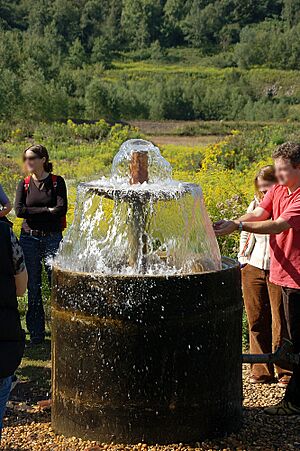Artesian aquifer facts for kids


An artesian aquifer is a special underground layer of rock or soil that holds groundwater under pressure. Think of it like a giant underground sponge squeezed between two hard layers. This pressure makes the water in a well drilled into it rise up on its own.
This kind of well is called an artesian well. Sometimes, the pressure is so strong that the water actually flows right out of the ground without needing a pump! When this happens, it's called a flowing artesian well.
An aquifer is any underground layer that can store and move water. This includes things like sand, gravel, limestone, or sandstone. An artesian aquifer is special because it's trapped between layers of rock or clay that don't let water through. This trapping creates the pressure. Water enters these aquifers from a higher place, like a mountain, which pushes it downwards.
What is an Artesian Well?
Artesian wells get their name from a place called Artois in France. The first artesian wells were drilled there a very long time ago, starting in 1126, by monks.
Where Can You Find Them?
Artesian aquifers are found all over the world. You can find them in places like Australia, the USA, Spain, Italy, the United Kingdom, Fiji, and Canada.
The biggest and deepest artesian system in the world is called The Great Artesian Basin. It covers a huge part of Australia, about 23% of the whole continent!
Images for kids
-
U.S. Navy Seabees tapping an artesian well in Helmand Province, Afghanistan
See also
 In Spanish: Pozo artesiano para niños
In Spanish: Pozo artesiano para niños




